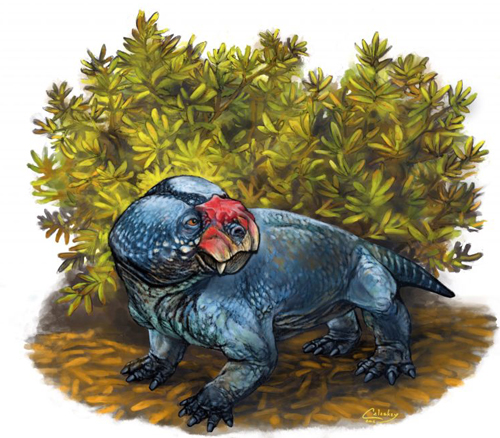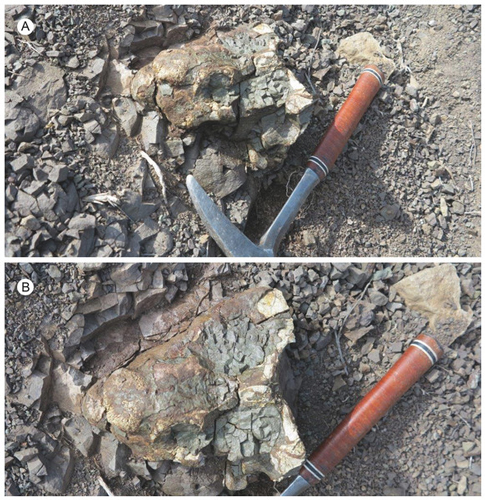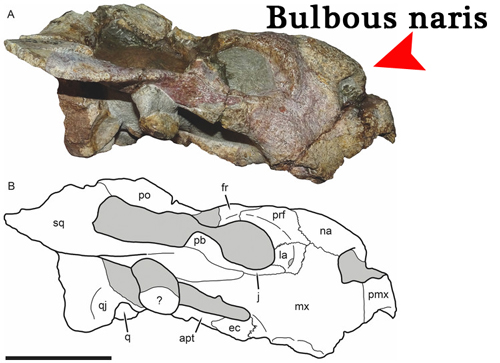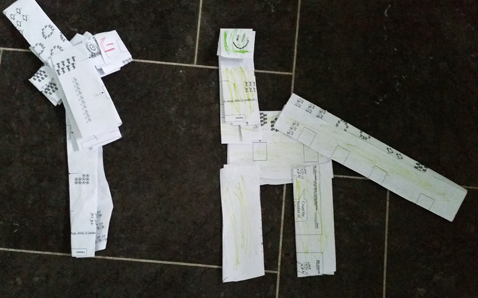New South African Permian Dicynodont Described
Dicynodont with a Big, Bulbous Nose – Bulbasaurus phylloxyron
The Karoo Basin of South Africa is famous for its Permian fossils. The rocks exposed in this part of the world, trace the geology of what was to become known as the super-continent of Gondwana, from the Late Carboniferous through into the Early Jurassic. It is the abundance of Permian-aged tetrapod fossils from the Beaufort Group of strata and its rock formations that have provided palaeontologists with a great deal of information about terrestrial life before the rise of the dinosaurs.
Researchers from the Museum für Naturkunde Berlin and the University of Witwatersrand have announced the discovery of a bizarre-looking new type of dicynodont, this critter may have been quite small, but it did have large tusks and strange, rough boss on its nose.
An Illustration of the Newly Described Late Permian Dicynodont Bulbasaurus phylloxyron
Picture credit: Matt Celeskey
Bulbasaurus phylloxyron
Described from skull material that was discovered preserved in 1.5 metre-deep mudstone, it is thought the head of this reptile was transported by a flood event before coming to rest in the mud. Over millions of years the mud became rock, preserving the skull and some of the teeth, including evidence of an impressive pair of tusks (located in the upper jaw).
Photographs of the Holotype Skull Material in Situ (SAM-PK-K11235)
Picture credit: Peer J
The photograph above shows two views of the holotype material (SAM-PK-K11235) taken from the excavation site. Picture (A) shows the skull in left lateral view, whilst (B) shows the dorsal view. The geological hammer provides scale.
A Bizarre Permian Dicynodont
The fossil material was discovered at Driekoppe, Vredelus, Fraserburg, Western Cape Province, by Dr Roger Smith (University of Witwatersrand), it was during a visit to view the collection of Permian fossils that dicynodont specialist Dr Christian Kammerer (Museum für Naturkunde Berlin), noted the skull showed a number of unusual features, most of which are associated with much younger types of Dicynodontians. Further study led to the establishment of a new species (B. phylloxyron). The genus name means “bulbous nose”, a reference to the large and roughened boss located on the naris bone.
c
Picture credit: PeerJ with annotation by Everything Dinosaur
The picture above shows a photograph of the sixteen-centimetre-long skull and an accompanying line drawing. The large, bulbous area of the naris (from which this animal has been named), is highlighted.
Key
sq = squamosal, qj =quadratojugal, apt = anterior pterygoid ramus, ec = ectopterygoid, fr = frontal, la = lacrimal, mx = maxilla, na = nasal, pmx = premaxilla, pb = base of postorbital bar, po = postorbital, prf= prefrontal and ? indicates an unidentified bone. The area shaded grey in the line drawing represents matrix.
For models and replicas of prehistoric animals including Permian creatures: CollectA Deluxe Scale Prehistoric Animal Models.
A Significant Permian Fossil Discovery
Bulbasaurus was found in rocks that have been dated to the early Lopingian Epoch of the Late Permian. It lived around 259 million years ago. The fossils are significant as Bulbasaurus is the oldest known member of a family of dicynodonts known as the Geikiidae. Its discovery helps to fill in a gap in the early fossil record of this important group.
The scientific paper: “An early geikiid dicynodont from the Tropidostoma Assemblage Zone (late Permian) of South Africa”, published in the journal PeerJ.
Visit the award-winning, user-friendly Everything Dinosaur website: Everything Dinosaur.






